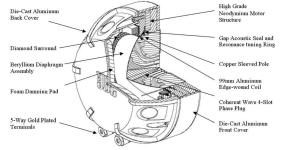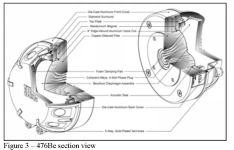So I’m planning on building a system along these lines for the horn section but instead replacing the 14” woofer with a pair of 8” drivers for an overall narrow presentation. Trying to figure out what JBL did here with the horn…..is it just an existing biradial modded and turned on its side?……JBL says 60 degrees horizontal in their literature but looking at the lens, how’s that possible?
Anyone have any data or points to share?…..I know there’s a member here who has them and I’ve auditioned them a while ago and remember them being really dynamic and engaging


Anyone have any data or points to share?…..I know there’s a member here who has them and I’ve auditioned them a while ago and remember them being really dynamic and engaging
but instead replacing the 14” woofer with a pair of 8” drivers
this will fundamentally change the dispersion characteristics in the upper passband of the woofer(s) and probably requires a different waveguide for directivity matching.
JBL Studio Series could be a better reference to start from with smaller woofers. https://www.audiosciencereview.com/forum/index.php?threads/jbl-studio-590-speaker-review.47269/
For the rationale behind the midrange horn, look up 'mantaray horn' and 'pattern flip'. The horn must be physically tall to retain its narrow vertical dispersion control.
Not sure what JBL was thinking with the 590…..xo at 1.5khz to an 8” woofer so far away…… vertical off axis has a huge hole right there too. A more robust CD capable of 1khz Xo would make more sense
On a side note, the 530 book shelf version looks a lot better on paper. Something like that crossed over to a dual 8” active sub below would be a nice system too
On a side note, the 530 book shelf version looks a lot better on paper. Something like that crossed over to a dual 8” active sub below would be a nice system too
I think they did quite a reasonable tuning. DI jump is only due to vertical energy around 2k, horizontal narrowing of the -6 dB is filled by further off-axis energy. Actual problem is port resonance sucking away SP around 1k and this together with WG blasting bit too much energy in the sky, creates stupid little dip there.
The very low 1k crossover I have not seen offered in any commercial CD-based 2-way. Another thing is bigger opening diameter of the CD limits HF dispersion. JBL 708P also uses smaller than 1-inch and showcases superior HF behavior dispersion wise.
The very low 1k crossover I have not seen offered in any commercial CD-based 2-way. Another thing is bigger opening diameter of the CD limits HF dispersion. JBL 708P also uses smaller than 1-inch and showcases superior HF behavior dispersion wise.
Do a search for Sam 1 Hf and Sam 2 Lf. Jbl beat you to it years ago.
Rob 🙂
Rob 🙂
I thought the 1400 was a 1.5 CD?Well yes same set-up as the 1400 except dual 8" different crossover
Rob 🙂
3" diaphragm, 1,5" exit.I thought the 1400 was a 1.5 CD?
Meaning a JBL 243X compression driver. In the case of the 1400 the 435 driver, which is a synthesis version with the deeper backup, else pretty much identical to the 2435.
Using a different phase plug geometry then the 245x drivers.
Sure.Thanks Arez.
Also as for the HF dropoff that is partly due to the phaseplug/throat of the 243X drivers, not only due to the 1,5" exit.
You can see the difference in the cross sections i added between the Cohherent wace phasing plug of the 245x/476, and that of the 243X (2435 in the pic) which has a more 'traditional geometry.
Attachments
- Home
- Loudspeakers
- Multi-Way
- JBL Synthesis 1400 Design Study


